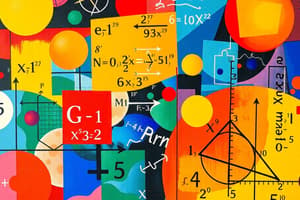Podcast
Questions and Answers
The properties of arithmetic include commutative, associative, and distributive laws.
The properties of arithmetic include commutative, associative, and distributive laws.
True (A)
A linear equation only contains variables and no constants.
A linear equation only contains variables and no constants.
False (B)
The Pythagorean theorem is applicable only to right triangles.
The Pythagorean theorem is applicable only to right triangles.
True (A)
Descriptive statistics includes measures such as mean, median, and variance.
Descriptive statistics includes measures such as mean, median, and variance.
Trigonometric ratios include sine, cosine, and tangent.
Trigonometric ratios include sine, cosine, and tangent.
Flashcards are hidden until you start studying
Study Notes
Key Concepts in Mathematics
-
Arithmetic
- Basic operations: addition, subtraction, multiplication, division
- Properties: commutative, associative, distributive laws
-
Algebra
- Variables and constants
- Expressions, equations, and inequalities
- Functions: linear, quadratic, polynomial, exponential
- Solving linear equations and systems of equations
-
Geometry
- Basic shapes: triangles, circles, squares, rectangles
- Properties: perimeter, area, volume
- Theorems: Pythagorean theorem, properties of angles
- Coordinate geometry: distance formula, midpoint, slope
-
Trigonometry
- Trigonometric ratios: sine, cosine, tangent
- Right triangles: relationships between angles and sides
- Unit circle and periodic functions
-
Calculus
- Limits: understanding behavior of functions
- Derivatives: rates of change, slope of curves
- Integrals: area under curves, accumulation
-
Statistics
- Descriptive statistics: mean, median, mode, range
- Probability: basic principles, independent and dependent events
- Distributions: normal distribution, binomial distribution, standard deviation
-
Discrete Mathematics
- Set theory: operations, Venn diagrams
- Graph theory: vertices, edges, paths, circuits
- Combinatorics: permutations, combinations
-
Mathematical Logic
- Propositions: true/false statements
- Logical operators: AND, OR, NOT
- Proof techniques: direct, contrapositive, contradiction
Study Tips
- Practice Regularly: Consistent problem-solving helps reinforce concepts.
- Visual Learning: Use diagrams and graphs to understand geometric and statistical concepts.
- Group Study: Collaborate with peers to discuss and solve problems collectively.
- Utilize Resources: Leverage online platforms, textbooks, and videos for diverse explanations and methods.
- Focus on Understanding: Aim to grasp concepts rather than just memorizing formulas.
Key Concepts in Mathematics
-
Arithmetic
- Fundamental operations include addition, subtraction, multiplication, and division essential for calculations.
- Properties include commutative (changing order does not change sum/product), associative (changing grouping does not change sum/product), and distributive laws (multiplying a number by a sum results in the same sum as multiplying each addend separately).
-
Algebra
- Composed of variables (symbols representing numbers) and constants (fixed values).
- Involves expressions (combinations of variables and constants), equations (statements of equality), and inequalities (comparisons showing one side is larger/smaller).
- Functions include linear (straight lines), quadratic (parabolas), polynomial (multiple terms), and exponential (growth/decay rates).
- Techniques for solving linear equations and systems are critical for finding unknown values.
-
Geometry
- Fundamental shapes include triangles, circles, squares, and rectangles with distinct attributes.
- Important measurements include perimeter (distance around a shape), area (space within a shape), and volume (space within 3D shapes).
- Key theorems include the Pythagorean theorem (relationship between sides of a right triangle) and properties of angles (rules governing angle relationships).
- Coordinate geometry involves formulas for calculating distance, midpoint, and slope between points on a plane.
-
Trigonometry
- Core trigonometric ratios are sine, cosine, and tangent, essential for understanding triangle properties.
- Right triangles exhibit consistent relationships between angles and side lengths.
- The unit circle aids in defining trigonometric functions and understanding periodic behavior.
-
Calculus
- Limits help analyze what happens to a function's output as the input approaches a specific value.
- Derivatives measure how a function changes, representing the slope or rate of change at a point.
- Integrals calculate the area under a curve, representing the total accumulation of quantity.
-
Statistics
- Descriptive statistics summarize data with measures like mean (average), median (middle value), mode (most frequent value), and range (difference between highest and lowest).
- Probability principles address how likely events are, differentiating between independent (unrelated outcomes) and dependent events (outcomes influence each other).
- Common distributions include the normal distribution (bell curve) and binomial distribution (success/failure scenarios), with standard deviation indicating data spread.
-
Discrete Mathematics
- Set theory covers operations involving sets, such as union, intersection, and uses Venn diagrams to visualize relationships.
- Graph theory examines networks through vertices (points) and edges (connections), exploring paths and circuits within structures.
- Combinatorics analyzes arrangements and selections, focusing on permutations (order matters) and combinations (order doesn't matter).
-
Mathematical Logic
- Propositions are assertions that can be classified as true or false.
- Logical operators include AND, OR, and NOT, used for constructing compound statements.
- Proof techniques such as direct (showing truth), contrapositive (proving opposite), and contradiction (demonstrating impossibility) are foundational for establishing validity in arguments.
Study Tips
- Practice Regularly: Engaging with problems on a consistent basis fortifies understanding of mathematical concepts.
- Visual Learning: Use diagrams and graphs to clarify relationships in geometric and statistical contexts.
- Group Study: Work alongside peers to enhance problem-solving and collaborative understanding.
- Utilize Resources: Explore multiple platforms, including online courses, textbooks, and instructional videos, to broaden perspective on topics.
- Focus on Understanding: Aim to truly comprehend concepts rather than relying on rote memorization of procedures and formulas.
Studying That Suits You
Use AI to generate personalized quizzes and flashcards to suit your learning preferences.




